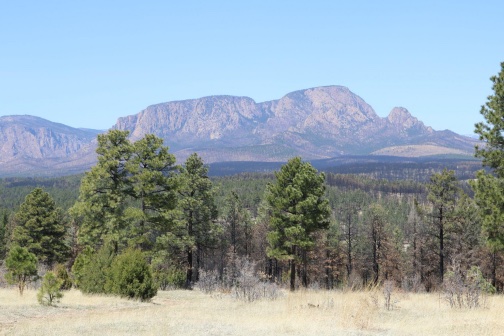Photo: Greenery of Hermits Peak, February 2022. Liberation photo
“It’s just so … sad,” said Tony Benavidez with tears in his eyes as he drove through the mountains of San Miguel County in Northern New Mexico. Just over a year ago, the most destructive fire in New Mexico history burned more than 340,000 acres of land, destroyed 900 buildings and forced 15,000 people to flee their homes.
On April 6, 2022, the U.S. Forest Service chose to begin a prescribed burn during an extreme drought in the region which quickly grew out of control. The Hermit’s Peak fire exploded, fueled by wind and dry conditions that had been in place for some time. Evidence was clear that the land was not suitable for a burn. Firefighters across the state had already battled three separate wildfires prior to the start of this prescribed burn.
Three days later, high winds in the area stoked an improperly extinguished burn pile just a couple miles west of the Hermit’s Peak fire. The burn pile had been lit by the Forest Service in January to clear brush and other debris that had collected from the year before. That fire quickly became the Calf Canyon fire.
By April 22, these two separate fires had consumed about 10,000 acres of land. High winds on that day brought the two fires together and broke any containment that firefighters had achieved up to that point. The next three months became a constant battle for area residents as they tried to protect their homes, livestock and families. It was not until Aug. 21 that the fire was officially contained. Some 341,471 acres were completely destroyed.
Then, the monsoons
The fire was contained in late August in large part due to the start of the annual monsoon season. The season starts in mid-June and runs through September. At first, the rain was a welcome sight in containing the blaze and preventing new spark ups, but soon a new challenge emerged — flooding. With burn scars throughout the mountains, debris rushed downhill damaging homes and land, making it hard for residents to even reach their homes. Driveways and the bridges that led to their homes completely disappeared.
“The water was up my driveway. It washed out the entire culvert in front of my house,” said Carlos Ortiz, a resident on State Highway 105.
To deal with the flooding problems federal and state officials set up “baskets,” which are metal nets that span gorges to catch debris. While they were set up in some valleys, residents of other areas were told to wait until after the flooding had already come.
“FEMA, they have some guys putting up those baskets to keep the flooding out of people’s homes. They’ve already marked it and got it ready, but where are they?” said Ortiz, speaking of the lack of work done in his valley.
This failure left many residents on their own trying to divert water away from their homes. Ortiz showed the work he did by hand to keep his barn safe. With just a shovel and a great deal of effort, and with the federal government absent, he dug more than 100 feet of canals.
‘Is it ‘cause we’re Hispanic?’
The 341,471 acres burned by the Calf Canyon/Hermit’s Peak fire is the most ever destroyed by a wildfire in New Mexico history. But the federal government and the state are no strangers to wildfires and responding to resident’s needs following the destruction.
After taking responsibility for starting the massive fire, the United States government has allocated nearly $4 billion to reimburse residents for the damage. So far, however, hardly any of that money has made its way to the people most affected. It is a stark contrast to the response to a fire just two decades before.
In May 2000, the Cerro Grande fire near Los Alamos displaced about 15,000 people. As soon as August 2001, more than $230 million had been distributed to home and business owners. Los Alamos is known nationally as the home of the Los Alamos National Laboratory. The area surrounding LANL is notably more affluent than San Miguel County.
“I talked to a guy who was in the fire at Los Alamos He said they came in and started handing out checks to all the homeowners … Where are they now?” said Ortiz with a half-hearted laugh. “What’s the deal? Is it cause we’re Hispanic and we live in the rural area? It just makes me wonder about stuff like this.” Ortiz said he has filed paperwork with multiple agencies including FEMA and the USDA, but has yet to hear back about when he could see his reimbursement. Now, he doesn’t even know if it will be worth it to try to get the money. It’s a feeling that runs deep in these isolated mountains.
In May, Democratic U.S. Senators Ben Ray Luján and Martin Heinrich and Democratic U.S. Representative Teresa Leger Fernández, representatives for the area, finally made a push for FEMA to hold up their end of the bargain. It took the representatives who live in New Mexico more than a year to speak out in support of those devastated by this fire. As their constituents shivered in their mobile homes and struggled through the worst year of their lives, their elected officials couldn’t be bothered to speak on their behalf.
FEMA initially marked 140 households for emergency housing due to the fire. Only 17 people ever received their mobile homes. Residents like David Martinez told ProPublica that because he purchased an older mobile home to live in while he waited on FEMA, he was no longer eligible for housing.
For many residents of northern New Mexico, their homes, livelihoods and communities were ripped apart by the U.S. Forest Service’s mismanagement. Now, more than a year later the residents of these small mountain towns are still fighting for their dignity.





